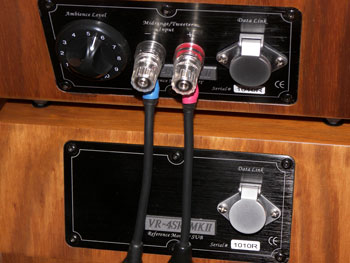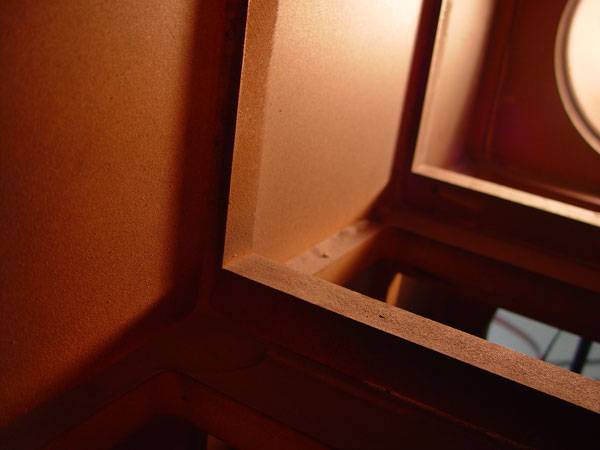The midrange used since 2001 is handled by a 7” cone material called “Aerogel”, which is a combination of paper fibers, Kevlar threads, carbon fiber powder and several binding chemicals. This is the same midrange used in the VR-11SE retailing at $150,000! Von Schweikert claims that this driver has, “…greater clarity and dynamic range than our reference electrostatic speaker.” From my comparisons to the Eminent Technology LFT-8A, which is a push-pull dynamic-planar speaker, the 4SR2 was every bit as quick, lithe and emotive, and with a huge advantage over the preponderance of skinny tower speakers I’m seeing today.
There are scads of thin floor-standing speakers being produced throughout the pricing spectrum designed to be aesthetically pleasing to the audiophile, purportedly without compromising aural integrity. Midranges in these speakers are typically 3-5”, and often are bunched. It’s typical to see twin 4” or 5” mids in speakers costing upwards of $5-6,000.00 and even with bass drivers in 6”! In a mind twisting development, it’s now common to see mids and bass drivers of the same size creating the “2.5 – way” speaker. The size of drivers has been shrinking; whereas years ago 12” to 15” bass drivers were common and mids on floor-standing speakers were sizable, now it’s not uncommon to find “tower” speakers with dual 5” mid/bass drivers! Many manufacturers have succumbed to the slimmer design to appeal to HT applications, so they’ve scaled down their drivers.
The speed, the cone’s structural integrity and stronger, lighter materials for resilience when pushed to higher levels, etc. all plays into the changes; but I wonder if it’s been taken too far.
There is an undeniable sonic richness to using a larger midrange driver. Smaller midranges can sound downright limited in comparison. Even when mids are done exceptionally well, as in the Chapman T-77’s, where twin 5” Scanspeak mid (technically, they are mid-bass drivers serving as midrange) drivers are employed, there is more expansiveness to instruments and vocals in the 4SR2’s single 7” that smaller drivers simply cannot convey. Midrange is what melts the audiophile’s heart, and the Aerogel warms me up every time I hear it.
Turning to the top-end, twin high frequency drivers are used to great effectiveness. A Vifa 1.5” (Scanspeak designed) Dual Ring Radiator with its phase plug pointing out like a bullet faces forward, while the more conventional looking rear-firing 1” ambience driver with fabric dome and transmission line-loading shoots toward the rear walls. The rear driver has its own ambience derivation circuit with complete “Dimension Control” for the level.
It seems Von Schweikert is trying to gain a nuanced reverberative effect similar to that as produced by some bipolar speakers, but with more finesse. In this case, the use of the rear-firing driver is rather necessary to balance the high-end with the mid/bass. When I turned off the rear driver, the high-end was subdued to the point of being overwhelmed by the rest of the frequency spectrum. In a room with highly reflective walls, it may be possible to dial down the rear driver to the point of nominal contribution; but that would be the exception rather than the norm. The presence of the reflected high frequencies adds a depth to the sound, which is at once diminished without the rear driver.
This is a major component of the “room interactive design” of the speakers. Von Scweikert chooses to design speakers which will purposely interact with room boundaries. Consequently, placement is critical for the proper results with VR speakers as the rear drivers bounce high-end frequencies off the rear (behind the speaker) walls to yield a more holographic sound than traditional forward-firing speakers. Von Schweikert describes their speakers as, quasi-omnidirectional transducers, a fancy term that means they utilize two sets of sound waves to recreate the original setting of the recording. The initial wave launches from the front of the speaker, and the secondary wave reflects off the room’s boundary surfaces.
It works. The 4SR2’s were located approximately 30” in from each side wall and 40” from the front wall in my 23’x13’x8’ listening room. The front wall corners have sound absorption panels placed at right angles approximately 3 feet high off the floor. This was done to reduce the strong reflected waves of planars, but it has also had the effect of creating a wonderfully reflection-free background for dynamic speakers as well. Use of the panels has allowed speakers to acoustically stand out like Lotus flowers emerging from mire. Whereas many listeners deal with rooms that are too interactive, too reverberant and intrusive, I had to dial up the ambience drivers to gain a sense of the omnidirectional nature of the sound.
The 4SR2’s allow not only high frequency adjustment, but also tuning of the bass module. The forward-firing bass ports are large enough that one can play surgeon and probe the cavities of the module in a procedure to save the low-end’s life…Ok, enough E.R. (rhymes with V.R.!). One can stuff wads of Pollyfil into the woofer cavity itself, or simply stuff the port tube to one’s desire. It’s not that the cabinets are resonant; they are well constructed and do not need the stuffing. It’s only if the bass is beating the stuffing out of you that the Pollyfil procedure is necessary.
And it very well may be necessary, since twin 8.5” aluminum woofers produce an utterly smooth but powerful low-end. I found that utilization of the Dussun V8i or the Channel Islands D-200 mono block amps, both very powerful amplification systems, was revelatory of the bass capabilities of the 4SR2’s! Can they reveal bass! I fancy myself a bass lover, but there are moments when I can’t take it to such a degree.
One instance was when an audiophile acquaintance let me hear his system with Klipsch speakers sporting 15” woofers as well as twin subs with 12” drivers driven by vintage McIntosh amplification – all in a 10×12’ room! Bass was ALL I recall hearing! Thankfully, the 4SR2’s were not remotely close to that; the low-end was strong, tight, powerful, yes even subwoofer-like but extremely controlled and, if a bit strong to my tastes, certainly not grotesquely proportioned to the mids/highs.
I can imagine that rock addicts would be in glory with the ability of these speakers to pound out bottom-end in such a clean fashion. My tastes, however, run toward smooth jazz and instrumental solos. In my experience, these speakers are made for tubes, at least tubes somewhere in the amplification chain. The two most noteworthy experiences I had were with the Pathos Classic One MkII tube hybrid’s (2) in bridged mode, and the newly minted Eastern Electric BBA “Buffer” Amp with the aforementioned D-200 monos.
- ← Previous page
- (Page 2 of 3)
- Next page →



Incredible speakers!!!!
Could you please send me additional literature on your latest and best.
Thank you.
Timothy Bildstein, MD.
I’m a lucky owner of a pair of VR4SR MKII speaker in African Hazelwood finish signed by Albert himself. Through the past 10 years I’ve been listening to many other high rated speakers, but nothing has ever come close to Alberts incredible constuction as the VR4SR! Not even speakers 3 times the price